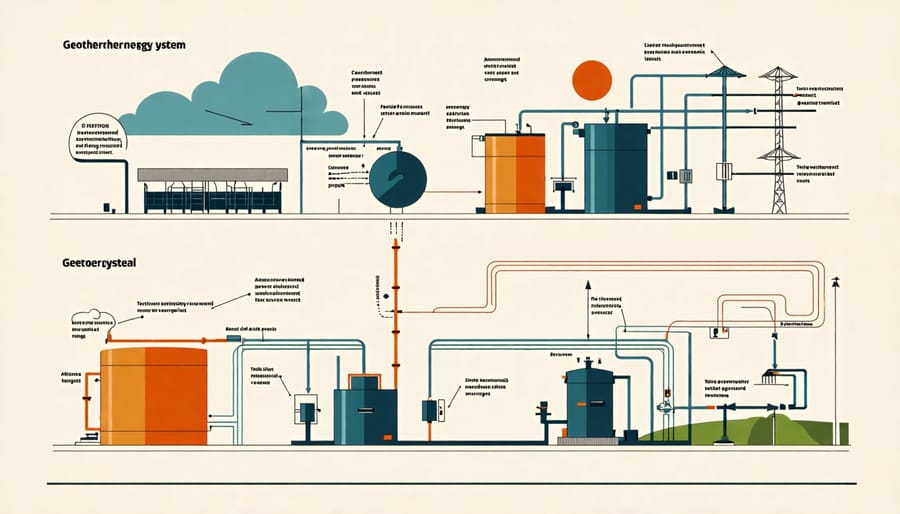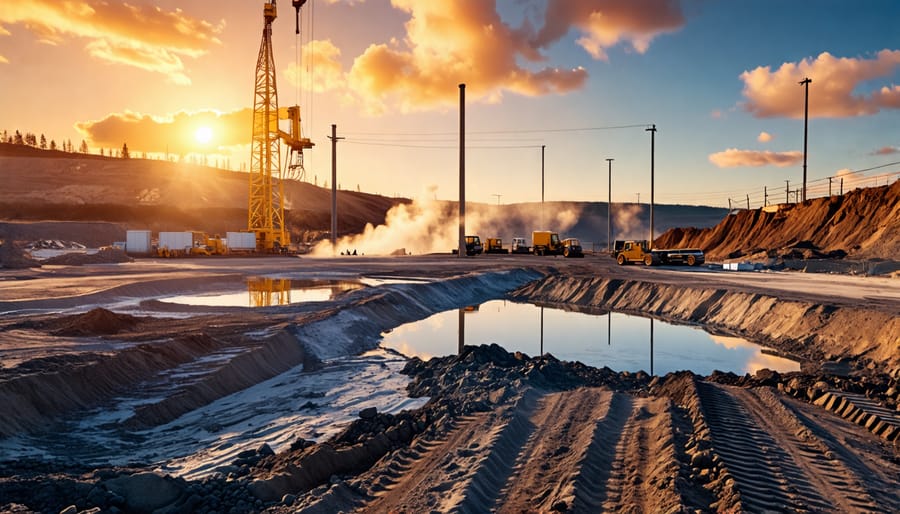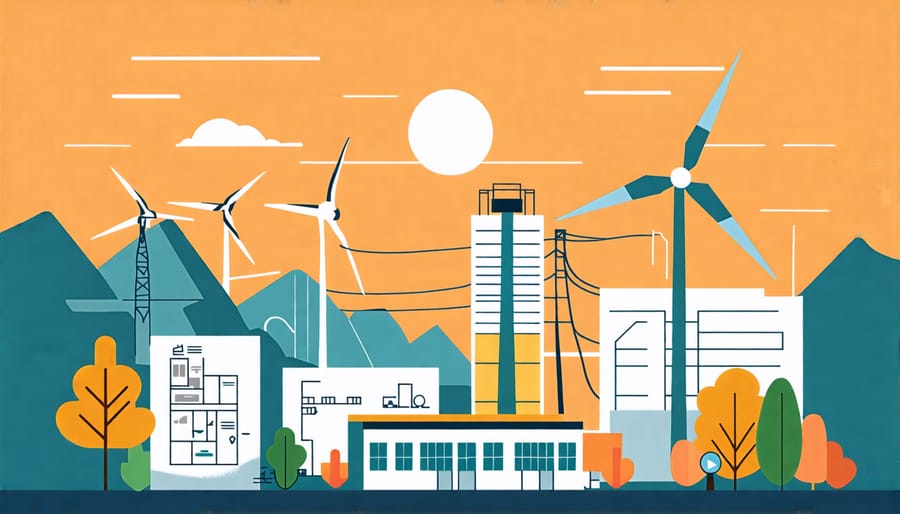Geothermal energy is revolutionizing the construction industry, offering a sustainable, cost-effective, and efficient solution for heating and cooling buildings. As the demand for renewable energy surges, geothermal systems are emerging as a game-changer in the built environment. By harnessing the Earth’s constant underground temperatures, these innovative systems provide a reliable, environmentally friendly alternative to traditional HVAC methods. From residential homes to commercial complexes, geothermal technology is being integrated into construction projects worldwide, reducing carbon footprints and operational costs while enhancing occupant comfort. As the industry embraces this transformative technology, geothermal energy is poised to reshape the future of construction, ushering in a new era of sustainable, energy-efficient buildings.
Geothermal Energy Fundamentals
How Geothermal Systems Function
Geothermal systems harness the Earth’s natural heat for energy production. The process involves drilling wells into underground reservoirs to access hot water and steam. These fluids are brought to the surface and used to drive turbines connected to electricity generators. After the steam condenses back into water, it is returned to the reservoir to be reheated, creating a closed-loop system. The three main types of geothermal power plants are dry steam, flash steam, and binary cycle systems, each suited for different reservoir conditions. Geothermal heat pumps, another application, use the stable temperatures just below the Earth’s surface to heat and cool buildings. These systems circulate water or a refrigerant through underground pipes, transferring heat to or from the building as needed. With proper reservoir management, geothermal systems can provide a reliable, sustainable energy source with minimal environmental impact, making them an attractive option for the construction industry.

Geothermal vs. Traditional Energy in Construction
Compared to traditional energy sources, geothermal offers significant advantages in construction. While upfront costs may be higher, geothermal systems provide long-term cost savings through reduced energy consumption and lower maintenance requirements. In terms of energy efficiency, geothermal heat pumps can achieve efficiencies up to 600% by leveraging the stable temperatures below the earth’s surface. This translates to substantial reductions in heating and cooling costs for buildings. Environmentally, geothermal is a clean, renewable resource that emits minimal greenhouse gases, making it an attractive choice for sustainable construction projects. Unlike fossil fuels, geothermal energy does not contribute to air pollution or rely on finite resources. As the construction industry increasingly prioritizes green building practices, geothermal presents a compelling alternative to conventional energy sources that aligns with sustainability goals while delivering long-term financial and operational benefits.
Geothermal Applications in Construction
Heating and Cooling Systems
Geothermal energy is increasingly used for heating, ventilation, and air conditioning (HVAC) systems in residential and commercial buildings. These systems leverage the stable temperatures found underground to efficiently heat and cool indoor spaces. By circulating a heat transfer fluid through a network of underground pipes, geothermal HVAC systems can extract heat from the earth in winter and transfer excess heat back into the ground during summer. This process significantly reduces the energy required for heating and cooling compared to traditional HVAC systems.
Geothermal HVAC systems offer numerous benefits, including lower energy bills, reduced carbon emissions, and improved indoor comfort. They are also known for their durability and low maintenance requirements. As the construction industry shifts towards more sustainable practices, geothermal HVAC is becoming an increasingly popular choice for both new construction and retrofits of existing buildings. However, the initial installation costs and site-specific geological requirements can present challenges for wider adoption.

Power Generation for Construction Sites
Geothermal power plants can provide a reliable source of clean electricity for construction sites, reducing reliance on fossil fuels and minimizing environmental impact. By harnessing the Earth’s heat, geothermal generators produce a steady supply of power to run heavy equipment, lighting systems, and other essential tools. This renewable energy option is particularly beneficial in remote locations where grid access may be limited. Geothermal plants can be scaled to match the specific energy needs of a construction project, ensuring optimal efficiency and cost-effectiveness. With proper planning and integration, geothermal power generation can significantly reduce a construction site’s carbon footprint while providing a dependable energy source throughout the build process. As the industry seeks more sustainable practices, utilizing geothermal energy for on-site power generation is an increasingly attractive solution for forward-thinking construction professionals.
Innovative Geothermal Building Materials
Innovative geothermal building materials are revolutionizing construction projects, offering sustainable solutions that harness the Earth’s thermal properties. From thermally-enhanced concrete to phase-change materials, these cutting-edge innovations are transforming how we construct energy-efficient buildings. For example, geopolymer concrete, made from industrial waste products, exhibits excellent thermal conductivity and can effectively transfer geothermal energy. Additionally, advanced insulation materials, such as aerogel and vacuum insulated panels, provide superior thermal resistance, reducing heat loss and optimizing geothermal system performance. By integrating these resilient technology solutions, architects and engineers can create buildings that seamlessly integrate with geothermal energy systems, maximizing efficiency and minimizing environmental impact. As the construction industry continues to prioritize sustainability, the adoption of innovative geothermal building materials is set to accelerate, ushering in a new era of green building practices.
Challenges and Opportunities
Costs and Financing
The costs of geothermal energy construction projects vary based on factors such as location, system size, and technology used. While initial capital investments can be significant, geothermal systems offer long-term financial benefits through reduced energy costs and minimal maintenance requirements. Financing options for geothermal projects include traditional loans, government incentives, and innovative models like power purchase agreements (PPAs) and energy performance contracts (EPCs). These financing mechanisms can help mitigate upfront costs and make geothermal more accessible for construction projects. When evaluating the return on investment (ROI) of geothermal, it’s important to consider the system’s lifespan, typically 20-25 years for heat pumps and 50+ years for ground loops. Over time, the energy savings and reduced carbon emissions can provide a compelling ROI, especially as energy prices rise and sustainability becomes a greater priority in the construction industry. Conducting a thorough financial analysis and exploring available incentives can help determine the viability of geothermal for specific projects.
Policy and Regulations
Geothermal energy construction is shaped by a complex web of federal, state, and local regulations. At the federal level, the Geothermal Steam Act governs leasing for geothermal resources on public lands, while the Energy Policy Act provides incentives for renewable energy development. State policies vary, with some like California and Nevada having specific geothermal permitting processes. Local zoning laws and building codes also impact project feasibility. Navigating this regulatory landscape requires careful planning and coordination with agencies like the Bureau of Land Management, Department of Energy, and state energy commissions. Environmental assessments, permits for well drilling and plant construction, and compliance with safety standards are critical steps. Developers must also secure power purchase agreements with utilities, which are influenced by renewable portfolio standards in many states. As the industry evolves, streamlined permitting and supportive policies will be key to unlocking geothermal’s full potential in the built environment.
Future Outlook
The future of geothermal energy in the construction industry looks promising. Experts predict significant growth in the adoption of geothermal systems over the next decade, driven by increasing demand for sustainable building solutions and supportive government policies. As technology advances and costs decrease, geothermal is expected to become a more accessible and cost-effective option for a wider range of projects. The development of innovative drilling techniques and more efficient heat pumps will further enhance the viability of geothermal in construction. Additionally, the integration of geothermal with other renewable energy sources and smart building technologies presents exciting opportunities for creating net-zero energy buildings. With its vast potential for reducing carbon emissions and providing reliable, clean energy, geothermal is poised to play a crucial role in shaping the future of sustainable construction.

Conclusion
In conclusion, geothermal energy presents a promising solution for sustainable construction, offering a clean, renewable, and reliable energy source. As demonstrated through case studies and expert insights, integrating geothermal systems into building designs can significantly reduce carbon emissions, lower operating costs, and enhance energy efficiency. While challenges such as high upfront costs and limited awareness persist, the long-term benefits and increasing global demand for green buildings make geothermal an increasingly attractive option.
As the construction industry continues to prioritize sustainability and combat climate change, geothermal energy is poised to play a crucial role in shaping the future of the built environment. By embracing this innovative technology, construction professionals, architects, and engineers can lead the way in creating more sustainable, resilient, and energy-efficient structures. With ongoing research, technological advancements, and supportive policies, the adoption of geothermal energy in construction is set to accelerate, contributing to a greener and more sustainable future for generations to come.

